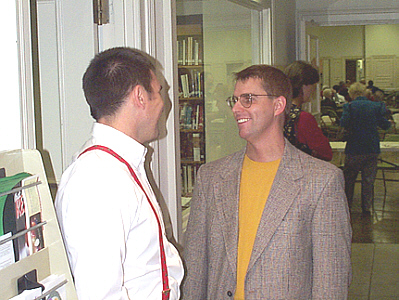General Board of Global Ministries
![]()
UM Information
UM
Reporter
![]()
Florida Southern College
![]()
Bethune
Cookman College
![]()
FL UM Children's Home
![]()
|
|
The Urban Anglo church |
|
Photo by Michael Wacht |
The Rev.
Jack Jackson, right, spends time with a member of First |
| By the Rev. Jack Jackson Rev. Jackson is associate pastor at First United Methodist Church, Orlando. In October 1998 he received a $9,000 grant from the Louisville Institute’s Study Grants for Religious Leaders Program to conduct a one-year study of successful church starts among all denominations. The following article contains some of the conclusions Jackson reached. ORLANDO — American society has made dramatic shifts toward urbanization in recent years, and the impact of these changes on mainline denominations is significant. Most denominations have historically been made up of primarily older, urban Anglo churches, sometimes as old as 200 years. Many have lost their vibrancy over the last few decades. Most denominations have recognized the need for new churches that reach specific groups in the city, including African-American, Asian and Hispanic populations. But most have also fallen short in planting new urban Anglo churches. This is beginning to change. All over the country, in major urban centers, both denominational and nondenominational churches are being planted with the goal of bringing unchurched white Americans into a community of faith. Sometimes this takes a very traditional form. Redeemer Presbyterian Church in Manhattan is a 10-year-old congregation that meets on a university campus on the Upper East Side for morning and evening worship every Sunday. Recently, it began a Sunday evening service on the Upper West Side. As many as 3,000 people attend the various services each weekend, many of whom grew up in church and left for a variety of reasons. Others are new to the Christian faith. Worship is traditional, except during one of the evening services, and includes multiple scripture readings, creeds, pastoral prayers and hymns played on an organ. In addition to reaching Anglo persons, nearly a third of the congregation is Asian. The church has also starting five other churches in greater New York City. Grace Seattle is a two-year-old church in the heart of Seattle, Wash., with approximately 250 worshipers. Ten percent are African-American, 30 percent Asian and 60 percent Anglo. Grace has a "liturgical funk" style of worship that appeals to all the ethnic groups and includes several traditional elements—pastoral prayer, hymns, multiple scripture. The musical leadership, which includes a partial orchestra, a band and lead singers, has a "funk" style (defined by the Cambridge International Dictionary as "a style of music, usually for dancing to, with a strong jazz-based rhythm and a tune that repeats itself") that is very different from the usual contemporary music. The words to the hymns are the familiar ones, but the tunes have been changed dramatically to reflect the musical tastes of young, urban Seattle. In Denver is Pathways Church, a church with Southern Baptist connections. It is attended mostly by Generation Xers who have never been churched. Worship is dark and mystical and held in an auditorium lit almost exclusively by candles. Services are led by a band that plays music with more of an edge to it than the traditional praise and worship music. The congregation averages between 200 and 250 persons, and the dark, but reflective, spirituality reaches out to them. In Minneapolis the urban church takes another form in the shape of Spirit Garage, a Lutheran church begun only a few years ago in a downtown neighborhood. Worship is fully contextual with many of the songs written by the church’s musicians. The music varies from hard rock to music similar to that of performer Alanis Morissette, a female vocalist whose alternative style includes electric guitars and angry or angst-filled lyrics. Worship ends around the communion table where the variety of people partake in the life of Christ, which some have only recently begun to grasp and some still seek. The churches differ greatly in style and format, but they are similar because each decided God’s call is for them to go to the inner city with the goal of bringing the good news to a community left out of new urban ministry in recent years. Top
of this page |

